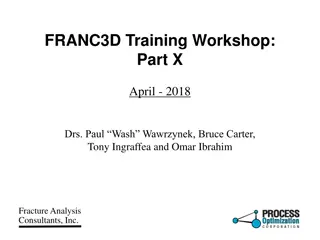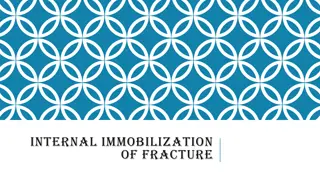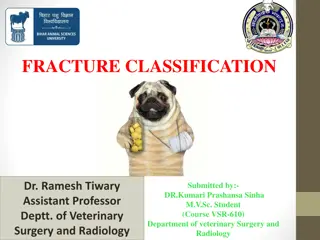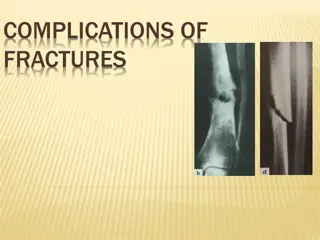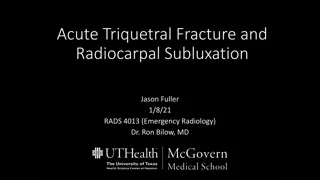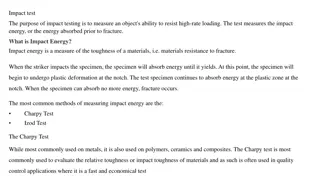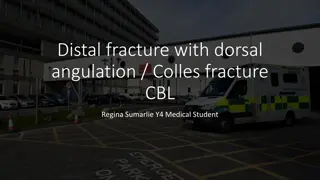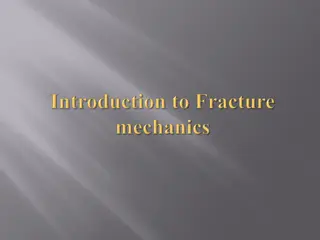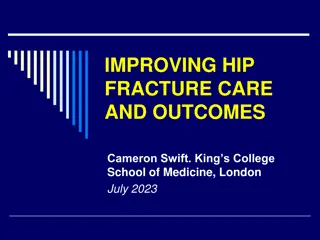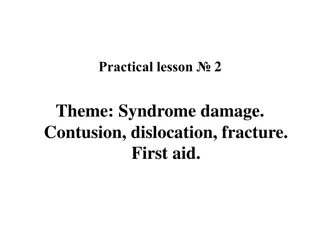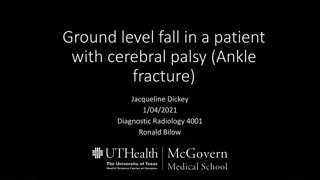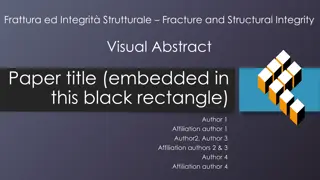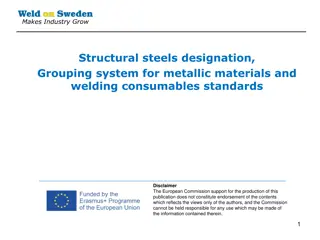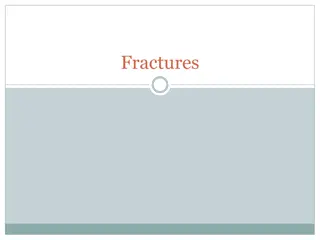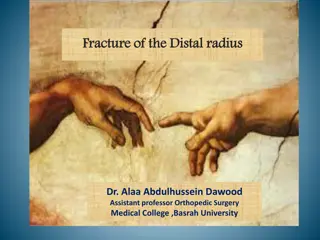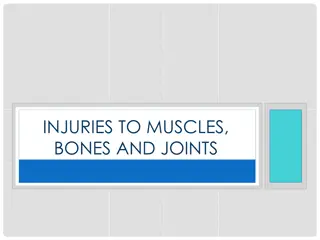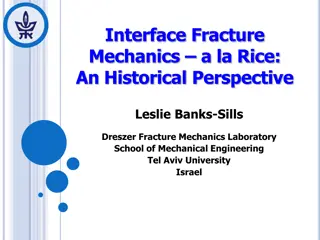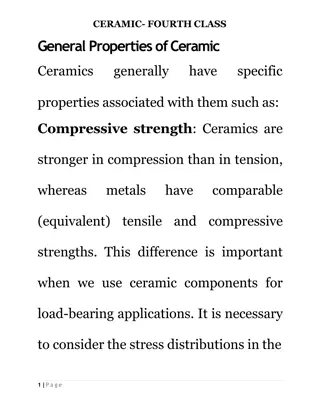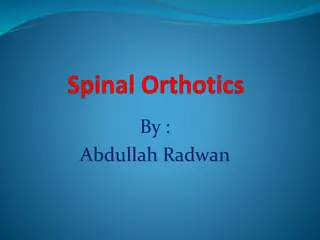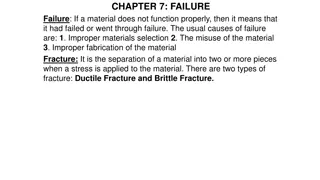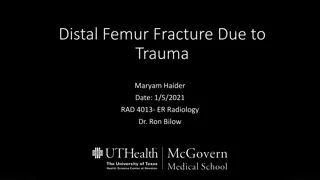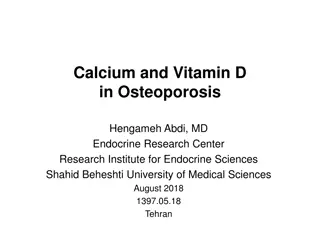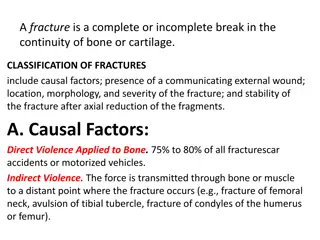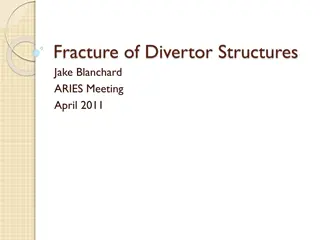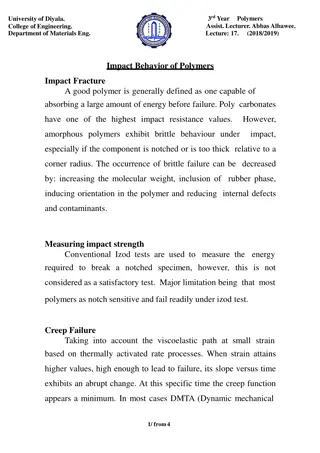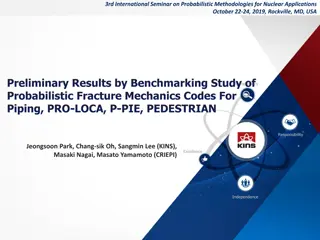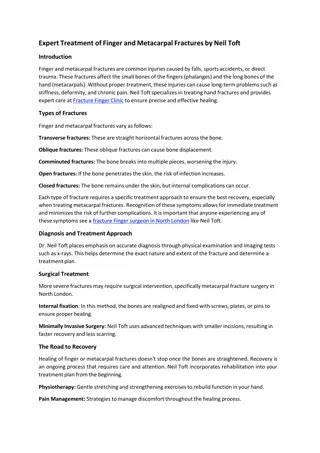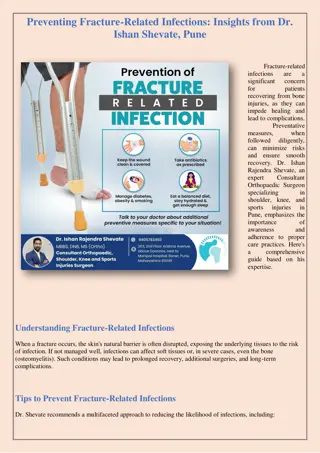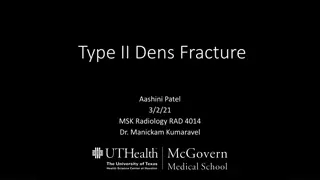Techniques of External Fracture Fixation in Veterinary Surgery
Dr. Archana Kumari, Asst. Professor and Junior Scientist in Veterinary Surgery and Radiology, presents various methods of external fracture fixation such as Robert Jones bandage, Ehmer sling, plaster cast, Thomas splints, walking cast, and hanging pin cast. The walking cast is indicated for fracture
1 views • 22 slides
Distal Radius Fracture Surgery Patient Information
A distal radius fracture, commonly known as a wrist fracture, is a break in the radius bone near the wrist joint. Surgery may be necessary to realign and stabilize the bone to prevent complications such as stiffness, weakness, and pain. After surgery, patients should watch out for signs of infection
0 views • 4 slides
Techniques of Fracture Reduction in Veterinary Medicine
Explore the techniques of fracture reduction in veterinary surgery, including closed reduction and toggling method, explained by Dr. Archana Kumari. Learn about the advantages of closed reduction, indications for treatment, and the step-by-step technique involved in reducing fractures in animals. Di
0 views • 14 slides
Understanding Repair and Addition to RPD in Dentistry
The need for repair or addition to an existing Removable Partial Denture (RPD) often arises due to various factors like occlusal disharmony, improper handling, or fatigue of metal components. Common fracture sites include midline, clasp fracture, and acrylic saddle detachment. The repair procedure i
1 views • 16 slides
Pediatric Dental Crown and Root Fractures Management Guidelines
Guidelines for managing pediatric dental crown and root fractures are provided based on the type and severity of the fracture, along with treatment recommendations, follow-up schedules, and parent/patient education tips. The content covers uncomplicated crown fracture, primary tooth enamel-dentine f
2 views • 9 slides
FRANC3D Training Workshop: Part X Overview
Explore the agenda, file handling, analysis results, and more from the FRANC3D Training Workshop Part X held in April 2018. The workshop covers fracture mechanics analysis, FRANC3D introduction, FE model import, crack insertion, static crack analysis, SIF computation, crack growth, fatigue life appr
1 views • 13 slides
Methods of Internal Immobilization for Fracture Repair
Various methods of internal immobilization for fracture repair in animals include intramedullary pinning and nailing, Rush pins, cross pinning, screws, wires, and plate fixation. These methods provide stability and alignment for bone fractures, with success rates depending on the size and weight of
0 views • 21 slides
Understanding Fracture Classification in Veterinary Medicine
Fractures in veterinary medicine can be classified based on various factors such as communication with the environment, extent of bone damage, and complexity of the injury. This comprehensive guide covers different types of fractures, including simple, compound, complicated, and incomplete fractures
2 views • 16 slides
Complications of Fractures: Types and Consequences
Fractures can lead to a variety of complications, both locally and generally. General complications include shock, embolisms, crush syndrome, and more. Local complications can involve visceral, vascular, nerve injuries, compartment syndrome, infections, and more. Late complications may result in del
0 views • 29 slides
Wrist Trauma: Acute Triquetral Fracture and Radiocarpal Subluxation
A 41-year-old female presenting after a high-speed MVC with injuries including a medially displaced radiocarpal subluxation and a comminuted Triquetrum fracture. There is also soft tissue swelling in the distal forearm and wrist. Treatment involves operative management of the fracture and fixation o
0 views • 15 slides
Understanding Impact Testing for Materials Evaluation
Impact testing is crucial for assessing the toughness and resistance of materials to fracture under high-rate loading conditions. Charpy and Izod tests are common methods used to measure impact energy and evaluate materials' performance. The tests involve striking a specimen with a striker and measu
2 views • 13 slides
Assessment of Mrs. McDonald's Right Wrist Injury: Colles Fracture Case Study
Mrs. McDonald, a 68-year-old female, presented to the emergency department with a painful and swollen right wrist after falling in her kitchen. She described a mechanism of injury involving a fall on an outstretched hand. Further evaluation revealed limited wrist function, significant pain, and a hi
0 views • 33 slides
Understanding Fracture Mechanics in Materials Engineering
Fracture in materials is the separation of a body into two or more pieces under static stress. Fracture mechanics studies how materials fracture and their resistance to it, focusing on crack propagation. Historical instances like ship and bridge failures illustrate the catastrophic effects of fractu
0 views • 17 slides
Enhancing Hip Fracture Care and Outcomes: A Comprehensive Approach
Improving hip fracture care and outcomes requires raising standards, implementing effective strategies, and ensuring multidisciplinary management. The Hip Fracture Programme Model outlines key elements including assessment, rehabilitation, and coordination across healthcare services. Through strateg
0 views • 35 slides
Practical Lesson on Syndrome Damage: Contusion, Dislocation, and Fracture First Aid
Learn the definitions, causes, and symptoms of contusion, dislocation, and fracture in this practical lesson. Discover the basics of first aid, types of immobilization, and principles of transport immobilization. Equip yourself with the knowledge and skills to perform specific first aid treatments f
0 views • 16 slides
Ankle Fracture in a Patient with Cerebral Palsy: Diagnostic Radiology Case Study
A 57-year-old male with a history of cerebral palsy presented with ankle pain following a ground level fall. Examination revealed a Danis-Weber type B3 fracture subluxation and a displaced age-indeterminant fracture of the talar neck with midfoot collapse. Key imaging findings included soft tissue s
0 views • 15 slides
Fracture and Structural Integrity Visual Abstract
This visual abstract paper explores the topic of fracture and structural integrity, presenting key findings and insights. The paper delves into the importance of maintaining structural integrity and understanding fracture mechanics. Through concise visual representations, the authors highlight the s
0 views • 6 slides
Understanding Structural Steels and Designation Systems in the Industry
Structural steels play a crucial role in various industries, with specific requirements like strength, toughness, weldability, and corrosion properties. The designation and grouping systems help classify metallic materials and welding consumables according to standards set by organizations like the
0 views • 12 slides
Impact of Surgical Treatment on Physiotherapy Outcome in Femoral Neck Fracture Surgery
Early mobilisation post-hip fracture surgery plays a crucial role in patient outcomes. A study at Our Lady of Lourdes Hospital, Drogheda, compared the rehabilitation progress of patients based on the type of surgery received: arthroplasty or internal fixation. Results showed that arthroplasty patien
0 views • 4 slides
Understanding Different Types of Fractures and Their Characteristics
Explore various types of fractures such as traumatic, pathologic, compressive, and more through detailed medical images and authentic reports. Learn about the severity of soft tissue damage, classifications by renowned professionals, and the significance of assessing soft tissue injuries. Delve deep
0 views • 28 slides
Distal Radius Fracture: Diagnosis, Management, and Complications
Distal radius fractures, particularly Colles fractures, are common injuries, often affecting elderly women due to osteoporosis. These fractures typically result from a fall onto an outstretched hand, causing dorsal and sometimes radial displacement of the distal radius fragment. Clinical features in
0 views • 32 slides
Comprehensive Guide on Injuries to Muscles, Bones, and Joints
Explore various types of injuries such as dislocation, sprain, and fracture affecting muscles, bones, and joints. Learn about the signs of injury, splinting techniques, and common locations for strains. Discover how to identify and handle injuries effectively to promote recovery and prevent further
0 views • 16 slides
Evolution of Interface Fracture Mechanics: A Historical Perspective
Interface Fracture Mechanics has evolved over the years with significant contributions from researchers like Griffith, Irwin, and Williams. The early years focused on linear elastic fracture mechanics, leading to the development of stress intensity factors and understanding crack propagation. Specif
0 views • 27 slides
Understanding Ceramic Properties: Strength, Brittle Behavior, and More
Ceramics exhibit specific properties such as high compressive strength, brittleness due to mixed ionic-covalent bonding, low fracture toughness, poor electrical and thermal conduction (except for some types), and chemical insensitivity. While strong in compression, ceramics are brittle and lack duct
0 views • 13 slides
Understanding Osteoporosis and Its Classification
Osteoporosis is a skeletal disease resulting in low bone mass and increased fragility. It occurs due to an imbalance in bone formation and resorption, leading to weakened bones and higher fracture risk. The disease is classified into primary and secondary types, with various subcategories based on a
0 views • 19 slides
Understanding Orthoses: Types, Indications, Mechanisms, and Effects
Orthoses are mechanical devices used to support, stabilize, and protect various body parts. They can be categorized into different types such as cervical, cervicothoracic, thoracolumbosacral, lumbosacral, and sacroiliac orthoses. Indications for spinal orthotics include stabilizing the spine after a
0 views • 34 slides
Understanding Material Failure and Fracture
The process of material failure and fracture, including ductile and brittle fractures, is essential in understanding why materials do not function properly. Ductile fracture involves plastic deformation and slow crack propagation, absorbing a lot of energy. In contrast, brittle fracture occurs rapid
0 views • 10 slides
Distal Femur Fracture Diagnosis and Management Overview
Maryam Haider, a 45-year-old male, presented with a severe distal femur fracture following a traumatic incident. This case includes initial history and physical examination findings, differential diagnosis considerations, relevant imaging studies depicting the extent of the injuries, and key finding
0 views • 19 slides
Update on Calcium and Vitamin D Supplementation in Osteoporosis
The study reviews the benefits and risks of calcium and vitamin D supplementation for bone health. It discusses the impact on bone loss, fracture prevention, fall prevention, and cardiovascular risks. Evidence suggests that increasing calcium intake may have limited effects on bone mineral density a
0 views • 30 slides
Understanding Fractures: Classification and Factors
A fracture is a break in bone continuity, classified by causal factors, presence of external wounds, location, morphology, severity, and stability post-reduction. Fracture causes include direct violence, indirect violence, bone diseases, and repeated stress. Fractures can be closed or open, with sev
0 views • 17 slides
Evaluation of Rock Permeability Variations Using Seismic Velocity Changes
Assessment of fractured rock permeability variations through seismic velocity changes using a coupled simulation of flow, mechanics, and fracture. The study discusses motivation, problem statement, challenges, existing approaches, advantages of the proposed approach, state-of-the-art, mathematical a
0 views • 27 slides
Understanding the Process of Crack Initiation and Propagation
The process of crack initiation and propagation in materials is essential to comprehend for assessing fracture risk. This involves calculating defect sizes using fracture toughness values and understanding how cracks develop under repeated stresses, leading to fast fractures. The direction of crack
0 views • 36 slides
Understanding Fracture Mechanics in Engineering Structures
Explore the world of fracture mechanics in engineering structures, encompassing the importance of stress fields, crack tip behaviors, fracture toughness, ductile versus brittle materials, and the influence of temperature dependence on material properties. Delve into the intricacies of crack initiati
0 views • 22 slides
Understanding Impact Behavior and Fracture Energy of Polymers
Polymers with high impact resistance are sought after for their ability to absorb energy before failure. Factors affecting impact behavior, such as molecular weight and orientation, are discussed. Methods for measuring impact strength and creep failure are explored, along with the advantages of blen
0 views • 5 slides
Numerical Modeling for Hydraulic Fracture Prediction on Fused Silica Samples
Goal of the project is to predict the overpressures required to fracture fused silica cylindrical samples using numerical modeling. The study focuses on a homogeneous pure material with known mechanical properties compared to experimental results from a lab-scale stimulation system. The model includ
0 views • 7 slides
Benchmarking Study of Probabilistic Fracture Mechanics Codes for Piping
This study presents the preliminary results of a benchmarking study on probabilistic fracture mechanics (PFM) codes for piping systems conducted by KINS and CRIEPI. The study aims to improve understanding, recommend best practices, and identify unexpected code behaviors for future enhancements. The
0 views • 37 slides
Best Bone Fracture Treatment in Novena
Are you looking for the Best Bone Fracture Treatment in Novena? Then contact Centurion Orthopaedic Centre. They are experts in diagnosing and treating a wide range of knee, shoulder, hip, and ankle problems, including injuries and degeneration. Their
0 views • 6 slides
Best Fracture Finger & Metacarpal Fractures Treatment Clinic in North London
NeilToft is a Consultant Surgeon for Fracture Finger & Metacarpal Fractures Surgery in North London, Stanmore, Pinner, Rickmansworth, Watford, etc. Book an Appointment for Fracture Finger & Metacarpal Fractures Treatment.\n
1 views • 2 slides
Fracture-Related Infections - Dr. Ishan Shevate (1)
This infographic by Dr. Ishan Rajendra Shevate focuses on preventing fracture-related infections. Key tips include keeping wounds clean and covered, taking prescribed antibiotics, managing health factors like diabetes and smoking, and maintaining a b
2 views • 3 slides
Diagnosis and Imaging Findings of Type II Dens Fracture in C2 Vertebrae
An 82-year-old female presented with head and neck pain after a fall without loss of consciousness. Imaging revealed a minimally displaced fracture at the base of the odontoid process (Type II Dens Fracture) in the C2 vertebrae. The differential diagnosis ruled out other traumatic injuries involving
0 views • 19 slides





